Ladder
J-shicho (ïÖ), C-zhengzi (ïÖí), K-Ãà(õï)
A sequence in which one keeps playing atari to the opponent¡¯s stones until the stones are driven to the edge of the board or to friendly stones and captured. The black stones in Dia. 1 are captured in a ladder.
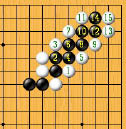 Dia. 1
Dia. 1
The three terms literally mean ¡®expedition¡¯ or ¡®hunt.¡¯
Ladder breaker
J-shichoatari (ïÖ?ª¿ªê), C-yinzheng (ìÚïÖ), K-Ãà¸Ó¸®
A stone that is located in the path of a ladder that makes it invalid.
 Dia. 1
Dia. 1  Dia. 2
Dia. 2
The Korean word literally means ¡®ladder¡¯s head.¡¯
Breaker for two ladders
J-Chinshinto(òåãêÔé), C-zhenshentou (òåãêÔé), K-Áø½ÅµÎ(òåãêÔé)
A ladder breaker that prevents two ladders, which is recorded in ¡®A Collection of Carefree and Innocent Pastimes (ØÎéØôèÕ¥ó¢)¡¯ as being first played by the qidaizhao Gushiyan(ÍÓÞÔåë),¡¯ when he played a game against a Japanese prince visiting China during the Tang dynasty.
Black 1 in Dia. 1 breaks both ladders with ¡®a¡¯ and ¡®b.¡¯
 Dia. 1
Dia. 1
Large diagonal move
J-hazama tobi (úõÊà-Þ«ªÒ), C- xiangbu fei (ßÚÜÆÞ«), K-¹çÀüÀÚ
A move played in the relation of a one-line jump both horizontally and vertically, or a shape which is made by such a move.
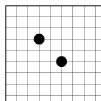 Dia. 1
Dia. 1
It is also called a ¡®diagonal jump.¡¯ However, as I define a ¡®jump¡¯ as a move that ¡®skips one or more lines toward the center¡¯ and it is not necessary for a ¡®diagonal jump¡¯ always to be made toward the center, there can be a certain inceherency in the definition. It seems fine to use ¡®large diagonal move¡¯ instead of ¡®diagonal jump¡¯ since there are ¡®knight¡¯s move¡¯ and ¡®large knight¡¯s move.¡¯
Large knight¡¯s approach
See approach.
Large knight¡¯s cap
See cap.
Large knight¡¯s enclosure
See enclose.
Large knight¡¯s move
J-ogeima (ÓÞÌýØ©), C-dafei (ÓÞÞ«), K-´«¸ñÀÚ [ÙÍ]
A play or a shape made one line further than the knight¡¯s move.
 Dia. 1
Dia. 1
Large knight¡¯s slide
See slide.
Leaning attack
J-motare, no C, K-±â´ë±â
A diversionary attack that attacks one group of stones by first attacking another group, inducing the opponent¡¯s answer. These stones then serve for the main attack.
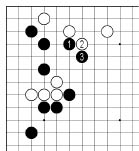 Dia. 1
Dia. 1
White attaches at 1 and bends with 3. Although these moves attack the white stones at the top, their real aim is the four white stones below. Black 1 and 3 are leaning attacks.
Liberty
J-dame (öîÙÍ), C-qi (?)£¬K-È°·Î(üÀÖØ)
A vacant point directly adjacent to a stone or stones.

The one stone in Dia. 1 has four liberties at ¡®a¡¯ to ¡®d.¡¯ The number of liberties can be increased or decreased depending on the number of stones connected each other, the shape of connection, and the location of a stone.
Cf. neutral point
Inside liberty
No J, C-neiqi (??), K-¾ÈÂÊ °ø¹è
A liberty inside the eye shape of a group.
 Dia. 1
Dia. 1
The two marked points are inside liberties only for Black.
Outside Liberty
J-gaidame (èâ?ÙÍ), C-waiqi (èâ?), K-¹Ù±ù °ø¹è
A liberty that is not shared by the opponent¡¯s group involved in the same capturing race and also not one that is in the opponent¡¯s eye-space.
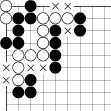 Dia. 2
Dia. 2
The marked points are White¡¯s outside liberties.
Shared Liberty
J-naidame (??ÙÍ), C-gongqi (Íë?), K-¾ÈÂÊ °ø¹è
A liberty shared by two groups which are involved in a capturing race.
 Dia. 3
Dia. 3
The marked points are inside liberties for both Black and White.
Liberty increase
No J, no C, K-¼ö ´Ã¸®±â
To increase the number of liberties to win a capturing race.
Black can double the number of liberties of the marked black stone from two to four by descending to 1, thereby can win the capturing race against the marked white stones.
 Dia. 1
Dia. 1
Life-and-death problem
J-tsume go (ýþѳ), C-sihuo ti (ÞÝüÀ?), K-»çÈ°¹®Á¦(ÞÝüÀÙýð¹)
A problem composed for the purpose of improving reading ability.
It is called a ¡®life-and-death¡¯ problem because it is usually about killing or saving stones.
 Dia. 1
Dia. 1
This diagram is an example of life-and-death problem. Try to kill the white stones.
Light
J-karui (Ì), C-qing (?)£¬K-°¡º±´Ù
A state of stones in which they are not solid or strong, but efficient and flexible, and can move quickly or easily sacrificed.
 Dia. 1
Dia. 1
The three white stone in Dia. 1 are light.
Opp. heavy
Lightning four
No J, C-wansi (?ÞÌ), K-¹ø°³»ç±Ã
One type of bent-four, called by that name because the shape looks like lightning bolt.
 Dia. 1
Dia. 1
The translation of this shape comes from the Korean term, and the Chinese literally means ¡®meandering four.¡¯
Line
J-sen (àÊ), C-xian (?)£¬K-¼±(àÊ)
There are 19 horizontal lines, and 19 vertical lines on a regular Go board.
First line
Another name for the 1st line is ¡®Line of Death¡¯ because one cannot make eye shape by playing on the 1st line, so the stones will eventually die.
Second line
It is also called the ¡®Line of Defeat¡¯ because moves played on the second line theoretically can make only one point of territory per move, so are very inefficient.
Third line
The nickname for the 3rd line is ¡®Line of Profit¡¯ since one can easily make territory by playing along the 3rd line and usually there is no need to worry about an invasion under it.
Fourth line
It is called the ¡®Line of Influence¡¯ because a move played on the 4th line has more powerful influence than a move on the 1st, 2nd or 3rd. It is hard to make territory by playing repeatedly on it because it is open to an invasion.
By the way, all these nicknames are true only in the opening stage, when many big points exist. In the endgame stage, the 1st and the 2nd lines cannot be evaluated in this way.
Link
J-tsugi (ïĪ®), C-jie (ïÈ)£¬K-ÀÕ´Ù
To connect stones without skipping any line as Black 2 in Dia. 1.
 Dia. 1
Dia. 1
Cf. connect
Live
J-iku (ß檯, üÀª¯), C-huo (üÀ)£¬K-»ì´Ù
To meet the requirement of stones not to be killed
There are three basic requirements for living
1. to secure enough area to survive an invasion
2. to have two separate eyes
3. to make dual life
Loose Ladder
J-yurumi shicho (èЪßïÖ), C-huanzheng (èÐïÖ), K-´Ã¾îÁø Ãà, ºóÃà
A technique used to capture the opponent¡¯s stones by driving them to the edge of the board or to friendly stones.
It is similar to ¡®ladder¡¯ which also drives the enemy to a dead-end, but differs in the method. A ladder makes continuous ataris, but a loose ladder just blocks the way out.
 Dia. 1
Dia. 1
The translation of ¡®loose ladder¡¯ comes from the literal meaning of the Chinese charater ¡®èÐ.¡¯ The Korean ¡®ºóÃà,¡¯ literally means ¡®empty ladder.¡¯ ¡®Empty¡¯ refers to the blank intersection at ¡®a¡¯ in Dia. 1.
Losing move
J-haichaku (ø¨ó·), C-baizhao (?ó·)£¬K-ÆÐÂø (ø¨ó·)
A move that is evaluated to be the cause of defeat.
Loss-leader Ko threat
J-sonko (áß̤), C-sun jie (?̤)£¬K-¼ÕÇØ (áßúª)ÆÐ
A ko threat that suffers a loss to win the ko.
In this case, the value of the loss is smaller than that of the ko.
Low
J-hikui (¤), C-di (î¸)£¬K-³·Àº
A term describing the position of stones that are located on the second or the third line.
 Dia. 1
Dia. 1
The position of the white stones in Dia. 1 is low because all of them are located on the third line. When a position is low like this, it has little potential to become big territory.
opp. High
Lukewarm
J-nurui (讪¤), no C, K-¹ÌÁö±ÙÇÏ´Ù
A term referring to a move that has little influence on the opponent.
 Dia. 1
Dia. 1
Black 1 is a lukewarm move because it doesn¡¯t attack the white stones as severely as it would if it were played at ¡®a.¡¯
Meijin
Ù£ìÑ
A Japanese pronunciation for ¡®Ù£ìÑ.¡¯ In Japan, it was a title granted by the Shogun in the Edo period for life to the strongest player. That player would receive the rank of 9 dan. At any time, there could be only one 9 dan player. These days, it is the name of a tournament and the winner of that tournament is awarded the title, Meijin..
Middle-Game
C-zhongpan (ñé?), J-chuban (ñéÚï), K-Áß¹Ý(ñéÚï)
A stage of the game in which players attack, invade and reduce each other¡¯s territory, or defend on the basis of assets built in the opening.
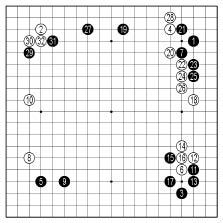 Dia. 1
Dia. 1
It can be said that when White answers Black 31 with 32, the middle-game begins.
Mimic Go
J-manego (òØÞÄѳ), C-mofangqi (Ù¼?Ѥ), K-Èä³»¹ÙµÏ
A game in which one player imitates the opponent¡¯s moves by placing stones on the diagonally opposite side of the board.
In diagram below, White is playing mimic Go.
 Dia. 1
Dia. 1
The Japanese ¡®mane(òØÞÄ),¡¯ the Chinese ¡®mo fang (Ù¼?)¡¯ and the Korean ¡®Èä³»¡¯ mean ¡®imitation.¡¯ It has been called ¡®mirror-go¡¯ and ¡®imitation-go¡¯ in English.
Mini-Chinese opening
J-mini jugoku ryu (ñé?×µ), C-mini zhongguo liu (Ú»?ñé?×µ), K-¹Ì´Ï Áß±¹½Ä(ñéÏÐãÒ)
A modification of ¡®Chinese opening,¡¯ that was popular in 1990s, which is characterized by Black 3, 5, and 7 in the diagram below.
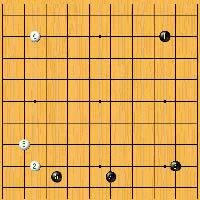 Dia. 1
Dia. 1
The relation between Black 3 and 7 is a variation of the original Chinese opening.
Monkey slide
J-saru-suberi (ê»üÁªê), C- xianhe da shentui (à¹?ÓÞãß÷Ú), K-´«º¹ÀÚ ³¡³»±â, ºñ¸¶(Þ«Ø©) ³¡³»±â
A large knight¡¯s move played in the endgame. Black 1 in Dia. 1 is an example.
 Dia. 1
Dia. 1
The right way to answer it is with the sequence from White 2 to 8 in Dia. 2.
 Dia. 2
Dia. 2
The monkey slide is a sente for Black and reduces White¡¯s territory more than the normal endgame attachment at 1 in Dia. 3.
 Dia. 3
Dia. 3
The ¡®monkey slide¡¯ is translated from the Japanese ¡®saru-suberi (ê»üÁªê).¡¯ The Chinese ¡®xianhedashentui (à¹?ÓÞãß÷Ú)¡¯ means ¡®A crane stretches its long legs¡¯ and the Korean ¡®ºñ¸¶(Þ«Ø©)¡¯ means a ¡®flying horse.¡¯
National hand
No J, C-guoshou (ÏÐâ¢), K-±¹¼ö(ÏÐâ¢)
The best player in a country.
The translation comes form the literal meaning of the Chinese charaters ¡®ÏÐâ¢.¡¯
Net
J-geta (ù»öî), C-jiachi (Ê®ýÞ), K-Àå¹®(íúÚ¦)
A capturing technique that blocks all avenues of escape of the opponent¡¯s stones without touching them.
 Dia. 1
Dia. 1  Dia. 2
Dia. 2  Dia. 3
Dia. 3
Black 1 in all three diagrams are nets.
Neutral point
J-dame (öîÙÍ), C-danguan (?ί), K-°ø¹è(ÍöÛÉ)
An empty point on the board, which is not a part of either player¡¯s territory and has no prospects of becoming territory.
Cf. liberty
 Dia. 1
Dia. 1
Assuming that the game ends as in Dia. 1, the three marked intersections are neutral points.
New Opening theory
J-shin fuseki (ãæøÖà´), C-xin buju (ãæøÖÏÑ), K-½ÅÆ÷¼®(ãæøÖà´)
An opening theory developed by Kitani Minoru (ÙÊÍÛãù) and Go Seigen (çïôèê¹) in 1933, emphasizing swift, large-scale development and outward influence instead of securing territory.
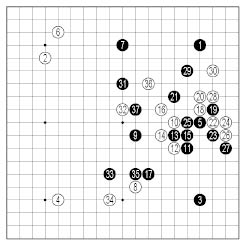 Dia. 1
Dia. 1
The sequence shown in Dia. 1 is a game that was experimentally played by Kitani Minoru as Black and Go Seigen as White according to their New Opening theory.
Nihon Ki-in (J)
ìíÜâѤêÂ
The Japanese Go Association. It is the largest of the two official Go orgarnizations in Japan. (The other is the Kansai Ki-in based in Western Japan.) It has more than 300 active players. In order to be eligible to play in newspaper tournaments and ultimately title matches, a Go player must be a member of one of these two orgarnizations.
Nose attachment
J-hanazuke (Þ¬Üõ), C-biding (Þ¬?)£¬K-ÄÚºÙÀÓ
An attachment at the protruding head of a group.
 Dia. 1
Dia. 1
White 1 in Dia. 1 is an attachment at Black¡¯s ¡®nose.¡¯
One-sided ko
See picnic ko
One-space
J-ikken (ìéÊà), C-yi jian (ìé?)£¬K-ÇÑ Ä
A prefix meaning a one-point gap between two stones.
One-space approach One-space enclosure




One-space expansion One-space jump One-space pincer



One-space approach
See approach.
One-space extension
See extend.
One-space jump
See jump.
One-way street
J-ipponmichi (ìéÜâÔ³), C-yibendao (ìéÜâÔ³), K-¿Ü±æ
An inevitable sequence.
The literal meaning of the Japanese and Korean words is ¡®single road.¡¯
Theoretically, there is no one way to play in Go, since the players can put stones wherever they want. Go differs in this characteristic from chess where each piece has a fixed way of movement. However, in certain situations, there are sequences that must be followed. The player that deviates could suffer an unacceptable loss.
 Dia. 1
Dia. 1 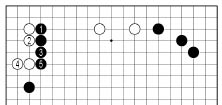 Dia. 2
Dia. 2
In Dia. 1, Black should block with 1 and play the sequence up to 7 because the sequence shown in Dia. 2 is bad for Black, because he cannot utilize the influence on the upper side, owing to the two white stones there.
On the board
J-Banmen (ÚïØü), K-¹Ý¸é(ÚïØü), C- panmian (ÚïØü)
The Chinese character ¡®ÚïØü¡¯ literally means the surface of the board. In Go, this word means the result on the board, before compensation is taken into account. If Black wins by four points on the board, he actually loses the game by two and a half points after the 6.5 points compensation is deducted.
Opening
J-fuseki (øÖà´), C-buju (øÖÏÑ), K-Æ÷¼®(øÖà´)
The initial stage of the game where the players place stones in preparation for middle-game fighting and for making territory.
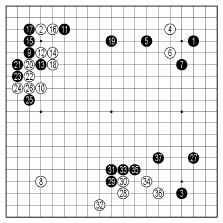 Dia. 1
Dia. 1
Dia. 1 is an example of the opening, which is taken from the game between Young-hoon Park and Yoda Norimoto at the final of the 17th Fusitsu Cup.
Open back door
J-susoaki (?Íöª), C-loufeng (ש?), K-µÞ¹®
A weakness in a territorial framework that is open to an intrusion by the enemy at the edge of the board.
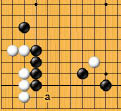 Dia. 1
Dia. 1
It has been called as ¡®open skirt¡¯ whose translation comes from the Japanese term ¡®susoaki.¡¯ The Korean ¡®µÞ¹®¡¯ literally means ¡®back door¡¯ and so when one adds a move to make territory invulnerable, the Koreans call that move ¡®¹®´Ü¼Ó¡¯ meaning ¡®locking the door.¡¯ The Chinese ¡®lou feng (ש?)¡¯ has a very similar connotation to the Korean term, that is ¡®When you are not sure to close a door then wind will come in through the gap.¡¯
Overall position
J-gokei (ѳû¡), C-xingshi (û¡?), K-Çü¼¼(û¡á§)
The territorial balance of a game
Over-concentration
J-chofuku (ñìÜÜ), C-chongfu (ñìÜÜ), K-Áߺ¹(ñìÜÜ)
An inefficient deployment of stone(s) with which the influence of friendly stones are not fully exploited.
 Dia. 1
Dia. 1
The marked stone of Black in Dia. 1 is mal-distributed since it is too close to the powerful wall of Black that allows the wider extension.
The literal meaning of the three Asian terms is ¡®overlapping, redundancy, or duplication.¡¯
Cf. dumpling shape
Overplay
J-murisuji (Ùí×âÐÉ), C-wuli qi (Ùé×âѤ), K-¹«¸®¼ö(Ùí×ââ¢)
A move that is unreasonable and takes too much of a risk.
Cf. strong play
Overtime counting
J-byoyomi (õ©ÔÁªß), C-dumiao (?õ©), K-ÃÊÀбâ
Extra count-down after the time allowed to a player has elapsed. Literally, all the Asian terms mean ¡®reading seconds.¡¯ It has been also called as ¡®second-counting.¡¯






